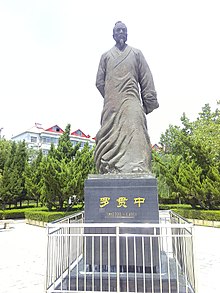Luo Guanzhong
Luó Guànzhōng ( Chinese 羅貫中 / 罗贯中 ), born as Luó Běn ( 羅 本 / 罗 本 ; * around 1330 in Taiyuan or Qiantang ; † probably around 1400 in Qiantang ) was a Chinese writer who wrote The Story of the Three Kingdoms and the publication of Attributed to the robbers from Liang-Schan-Moor . These are two of the most important adventure epics in Chinese literature .
Life
Almost nothing is known about the life of Luo Guanzhong. From the records of Jia Zhongming ( 賈仲明 / 贾仲明 ), who met him in 1364, we know that he must have lived at the end of the Yuan Dynasty and the early Ming Dynasty . He is said to come from Taiyuan , but some literary historians doubt this, and suspect Hangzhou and Jiangnan as his homeland, among others . According to Meng Fanren ( 孟繁 仁 ), Luo Guanzhong appears in the family tree of the Luo family. Then it would be very likely that his hometown is Taiyuan.
Recent research has shown that his date of birth is between 1315 and 1318.
Literary historians are not sure whether Shi Nai'an and Luo Guanzhong are the same person, or whether the name was used as a pseudonym by the editor of The Robbers of Liang Shan Moor so as not to be associated with motives critical of the government in his work .
Works
It is believed that the narratives that make up the core of The Tale of the Three Kingdoms and The Robbers of Liang Shan Moor were independently developed by several narrators. Shi Nai'an is considered to be the first to put the robbers together as a complete work. Luo Guanzhong put the book into the hundred-chapter form. Luo Guanzhong is widely regarded as the author of The Story of the Three Kingdoms , but Shi Naian is occasionally suspected of being the editor.
Sansui Pingyao Zhuan ( 三 遂平 妖 傳 / 三 遂平 妖 传 ), also known as Pingyao Zhuan ( 平 妖 傳 / 平 妖 传 ), is a ghost story in twenty chapters attributed to Luo Guanzhong. It grew out of stories of an uprising at the end of the Northern Song Dynasty . It was later expanded to 40 chapters by Feng Menglong ( 馮夢龍 / 冯梦龙 ).
Can Tang Wudai Shi Yanyi ( 殘 唐 五代 史 演義 / 残 唐 五代 史 演义 ) reports on the end of the Tang Dynasty and the following Five Dynasties and Ten Empires . It is a compilation of stories about the rebellion of Zhu Wen .
bibliography
- The Story of the Three Kingdoms ( 三國 演義 / 三国演义 , Sānguó Yǎnyì )
- The robbers from Liang-Schan-Moor ( 水滸傳 / 水浒传 , Shuǐhǔ Zhuàn ), controversial according to current research
- Sansui Pingyao Zhuan ( 三 遂平 妖 傳 / 三 遂平 妖 传 )
- Can Tang Wudai Shi Yanyi ( 殘 唐 五代 史 演義 / 残 唐 五代 史 演义 )
- Fenzhuang Luo ( 粉 妝 樓 / 粉 妆 楼 )
- Sui Tang Zhizhuan ( 隋 唐志 傳 / 隋 唐志 传 ), according to current research, the original has been lost
- Sui Tang Liangchao Zhizhuan ( 隋唐 兩朝 志 傳 / 隋唐 两朝 志 传 ), revised edition of Sui Tang Zhizhuan
Individual evidence
- ↑ Ouyang Jian, cited in Roberts 1991, p. 938
- ↑ "Sui Tang Zhizhuan (隋 唐志 傳 / 隋 唐志 传)" - Chinese: [1] - Retrieved January 28, 2017 - baike.baidu.com - Online
literature
- Moss Roberts (translation and afterword): Three Kingdoms: A Historical Novel University of California Press, 1991. ISBN 0-520-22503-1
- Yoshikawa Kojiro, Shimizu Shigeru (translator): 水滸 伝 (Water Margin) , Iwanami Shoten, 1998
- Conference contribution on The History of the Three Kingdoms from 1999 (Japanese) (PDF file; 22 kB)
- Qiping Zhao, Luo Guanzhong in Zhongguo da baike quanshu : Chinese literature , 1st edition
Web links
- Works by Luo Guanzhong at Project Gutenberg (Chinese)
- The Textual History of Sanguo Yanyi Authorship (English)
- Literature by and about Luo Guanzhong in the catalog of the German National Library
| personal data | |
|---|---|
| SURNAME | Luo Guanzhong |
| ALTERNATIVE NAMES | Luó Guànzhōng; Luo Ben; t = 羅貫中 (Chinese) |
| BRIEF DESCRIPTION | Chinese writer |
| DATE OF BIRTH | around 1330 |
| PLACE OF BIRTH | Taiyuan |
| DATE OF DEATH | around 1400 |
| Place of death | Qiantang |
